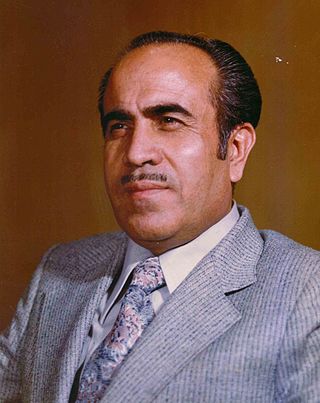
The Freedom Movement of Iran (FMI) or Liberation Movement of Iran is an Iranian pro-democracy political organization founded in 1961, by members describing themselves as "Muslims, Iranians, Constitutionalists and Mossadeghists". It is the oldest party still active in Iran and has been described as a "semi-opposition" or "loyal opposition" party. It has also been described as a "religious nationalist party".

Parliamentary elections were held in Iran on 13 March 1980, with a second round on 9 May. They were the first elections to the Majlis since the overthrow of the Shah, and were contested to a considerable degree on a party basis.

Parliamentary elections were held in Iran between 30 July and 20 August 1960.
Parliamentary elections were held in Iran in 1954. Political parties were banned from contesting the election, and all 136 elected MPs were independents.
The Movement of Militant Muslims is an Iranian Islamic socialist political group led by Habibollah Payman. The group had been revolutionary and is close to Council of Nationalist-Religious Activists of Iran.

People's Party was a liberal political party in Pahlavi-era Iran. It was one of two major parties in the apparent attempt to decree a two-party system by Mohammad Reza Shah, apparently in opposition to the ruling New Iran Party and previously the Nationalists' Party. The party was dissolved in 1975, in order to be merged into the newly founded Rastakhiz Party, the only legal party in the Shah's attempted single-party system.
JAMA is an Iranian political party founded in 1964. The party which was mainly active between 1979 and 1981 and a junior partner in the Cabinet of Bazargan, had been outlawed throughout much of its history due to dissenting the rule of both Pahlavi dynasty and the Islamic Republic.
Office for the Cooperation of the People with the President was a political organization in Iran that was closely associated to then-President Abolhassan Banisadr.

The Grand Coalition was the political alliance of Islamist groups contesting in the 1980 Iranian legislative election, led by the Islamic Republican Party. Various small fundamentalist groups joined the alliance.
The Eponym Group was an electoral list for the 1980 Iranian legislative election claiming "it would choose its candidates based on merit without regard to party affiliation". Close to the Freedom Movement, the group formed a minority in the parliament with approximately 15 to 23 seats. Due to internal conflicts, the Freedom Movement did not issue a list but its members were included in the Eponym list. The list had members of Freedom Movement, JAMA and Islamic Republican Party.
The Toilers Party of the Iranian Nation was a social-democratic political party in Iran.

Abdolkarim Lahidji is an Iranian lawyer and human rights activist.
Ali Espahbodi is an Iranian economist and politician.
Abolfazl Bazargan is an Iranian political activist and a senior member of the Freedom Movement of Iran.
Mohammad Bastenegar was an Iranian activist and spokesperson for the Council of Nationalist-Religious Activists of Iran.

Mostafa Katiraei was an Iranian engineer and politician who served in the interim government of Bazargan as the minister of housing. He was also a member of the Council of the Islamic Revolution.
Abbas Sami'i was an Iranian politician who held office as the third head of the Environmental Protection Organization.

Mohammad-Ali Angaji was an Iranian Shia cleric and politician. A loyal National Front member, he served as a member of parliament during the 17th term and ran for the 1954 election in Tehran. He was elected to the 73-seats Assembly of Experts for Constitution in 1979.
Ahmad Ghazanfarpour is an Iranian dentist and activist who served as a member of the parliament from 1980 to 1982.
Mohammad-Hassan Shamshiri, more known as Haj Hasan Shamshiri, was an Iranian bazaari restaurateur, philanthropist and civic patriotic activist.










